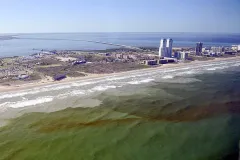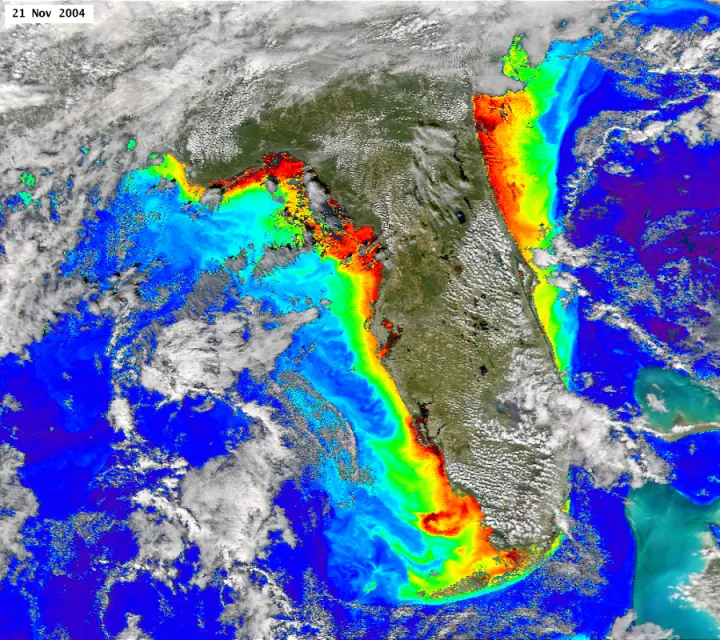What Exactly Is a Red Tide?

Drifting throughout the ocean, invisible to the naked eye, are innumerable microscopic algae. They come in many shapes and sizes—some geometrically beautiful, like the diatoms, and others, like the dinoflagellates, swim in a distinctive whirling pattern. These tiny algae are essential components to ocean life as they fuel the food web by harnessing light energy from the sun. But when supplied with excess nutrients, they can multiply uncontrollably, becoming an unwanted mass commonly called a “red tide” that smothers nearby ocean life.
This massive growth of algae can become harmful to both the environment and humans, which is why scientists often refer to them as harmful algal blooms or HABs. When nutrients from inland areas flow down rivers and arrive in the ocean they supply a nutritious feast for algae, causing them to rapidly grow. This can happen naturally as rivers flood and bring nutrient-rich soil from forests and grasslands, but it can also happen when fertilizer and excrement from livestock travel down those same waterways, or when coastal development leads to excess erosion. Some algae species, like the dinoflagellate Karenia brevis, color the ocean surface a deep red, inspiring the name “red tide.” But not all red tides are red and not all of them even become dense enough to color the water. There are also “brown tides” which can be damaging as well.
Often, the presence of a red tide is most visible due to its effect on the rest of the ecosystem. Many algae produce toxins that both taint the water and become airborne when they are at the surface. These toxins are harmful to marine mammals, birds, and turtles. This is because many of these larger carnivores are high up on the food chain, and the toxins accumulate as they ingest contaminated prey. Kerenia brevis, common along the Florida coast of the Gulf of Mexico, produces a neurotoxin called brevetoxin that disrupts the firing of nerve cells.
During a Kerenia brevis algal bloom manatees often wash ashore dead, both from ingesting and inhaling the noxious fumes. In a 1996 bloom, 149 manatees died off the coast of Florida and during a bloom which lasted from 1987 to 1988 over 740 bottlenose dolphins died after eating contaminated menhaden fish. Off the coast of California, an alga called Pseudo-nitzschia produces another neurotoxin that has a similar effect on sea lions, cormorants, and pelicans.
Humans, too, are impacted by the algae’s toxins. A particularly bad algal bloom will not only smell nasty enough to repel beachgoers, it can also cause illness to swimmers. Beach closures become necessary and can cause significant losses for the tourism industry—the National Oceanic and Atmospheric Administration estimates toxic algal blooms, which include red tides, account for the annual loss of roughly 82 million dollars in sales for restaurants, hotels, and other tourism industries within the United States. Shellfish naturally accumulate the toxins as they filter algae from the water for food. Consumption of tainted shellfish can lead to a serious illness that includes digestion issues, tingling sensations, a rapid heartbeat, coordination problems, or even death when medical treatment is not quickly sought after.
Not only do red tides create temporarily toxic oceans, they can also deplete the water of dissolved oxygen, causing a phenomenon known as a dead zone. When the algae die, they become a feast for microbes, like bacteria. These microbes, like animals, require oxygen, so as they feed on the dead algae they also multiply and consume much of the oxygen in the ocean. This leaves little available for fish and other creatures that breathe underwater. When the ocean becomes depleted of oxygen, fish can die en masse—leaving the ocean surface covered in floating, dead fish for as far as the eye can see.
Red tides are seasonal and often peak in the late summer when ocean conditions are the best for algae growth, however, off the coast of Florida they have been known to last for up to 18 months at a time. Although a natural occurrence (Spanish explorers remarked on the Florida red tides in the 1500s), studies suggest that harmful algal blooms are increasing in frequency, likely due to climate change and nutrient pollution from farming and landscaping.
But this does not mean the situation is hopeless—through concerted efforts in cleaning rivers and coastlines of excess nutrients, communities can curb the spread of these increasingly frequent red tides. Following a sudden population growth in the 1950s, Tampa Bay became covered in a thick mat of algae as mangroves were cleared and polluted water was dumped straight into the bay. Now, after over 40 years of restoration, the bay is cleaner than ever and the story of the community that came together to restore their waterways proves that recovery is possible.



